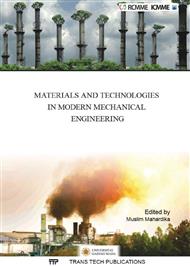p.99
p.103
p.111
p.115
p.120
p.127
p.132
p.141
p.147
Effect of Welding Current and Welding Time for Micro Resistance Spot Welding on Dissimilar Thin Thickness Materials of Al 1100 and KS 5 Spring Steel
Abstract:
In the dissimilar materials and dissimilar thin thickness sheets joining, welding current and welding time parameters of resistance spot welding (RSW) effect weld ability. RSW used for joining thin plate less than 1000 μm is called micro-resistance spot welding (μRSW). The objective of this article is to study the effect of welding current and welding time to the joining dissimilar thin thickness materials and the microstructure of a weld joint. The thickness of Al 1100 is 400 μm, and KS 5 Spring Steel is 200 μm. Welding parameters are Cycle Time 0.5, 1, 1.5, Welding Current 1kA and 2 kA, and holding time 10 second. Welding current 1kA, Cycle time of 0.5 produce maximum shear load of 227.4 N and fracture area of 6.644 mm2. Welding current 2 kA, cycle time of 1.5 affect maximum load of 222.7 N and fracture area of 10.559 mm2. Welding parameters lead to the majority fracture on aluminum material. The welding current and cycle time do not significantly affect maximum shear load and fracture area.
Info:
Periodical:
Pages:
120-124
Citation:
Online since:
June 2016
Authors:
Price:
Сopyright:
© 2016 Trans Tech Publications Ltd. All Rights Reserved
Share:
Citation:


